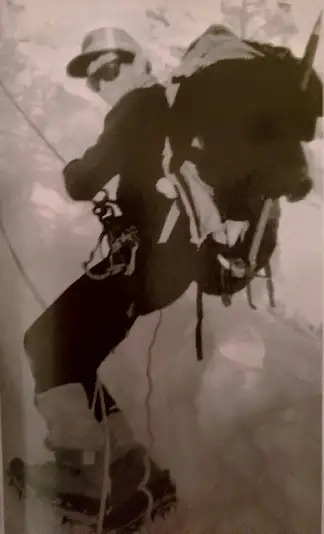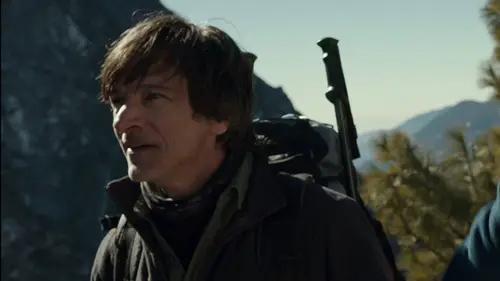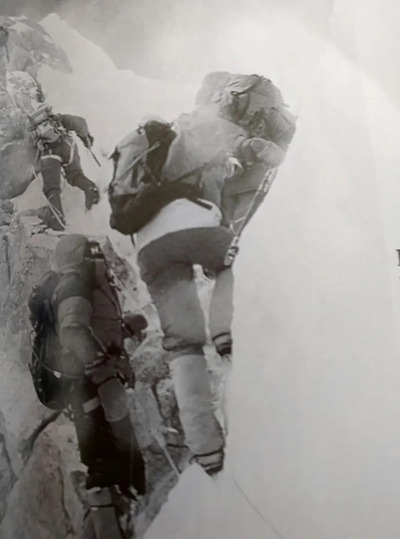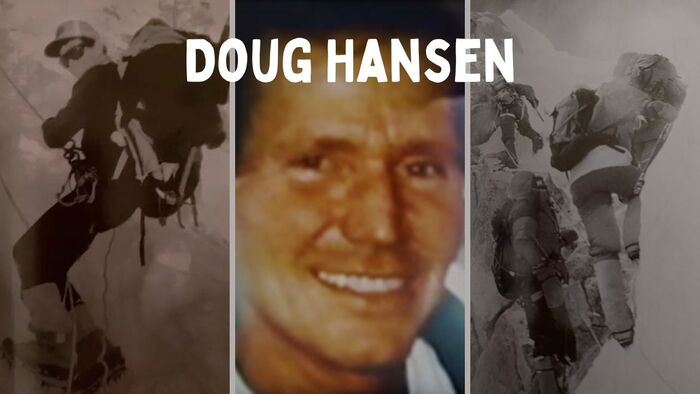Doug Hansen, an American climber and postal worker, tragically lost his life during the 1996 Mount Everest Disaster. Hansen, dubbed “mailman” due to his occupation, joined Rob Hall’s Adventure Consultants team with the aim of summiting Everest that season. Regrettably, the expedition took a disastrous turn. This was due to a combination of factors, including poor decision-making, a severe blizzard, and unforeseen delays.
In 2015, Universal Studios released the commercially successful film “Everest“. It featured featuring star-studded cast including Jason Clarke, John Hawkes, Keira Knightley, Jake Gyllenhaal, and Michael Kelly.
The movie was based on real events and went on to achieve a worldwide box office gross of $203 million. In the film, John Hawkes portrayed Doug Hansen, the determined mailman who conquered Mount Everest.
Quick Facts on Doug Hansen:
- Doug Hansen was nicknamed as the “mailman” as he worked as a postal worker.
- His 1996 Everest expedition was funded by the the students of Sunrise Elementary School. They sold T-shirts to help fund his climb.
- His first attempt to summit Everest with Hall was in 1995. However, he was forced to turn back due to bad weather and the summit was only 300meters away from his reach.
- Beck Weathers and Doug Hansen bonded during the 1996 Expedition. Weathers was sad when he realized his friend was not coming back.
Who was Doug Hansen?

Doug Hansen was born in 1949 in Seattle, Washington, and grew up in a poor family. Despite his difficult circumstances, he worked hard and had two jobs. One as a postal worker and the other as a driver, to support himself. Even from a young age, Hansen dreamed of conquering Mount Everest, the tallest mountain in the world.
Living close to Mount Rainier, near Seattle, may have influenced Hansen’s desire to climb Everest. As he got older, his determination to reach the top of Everest only grew stronger. Doug Hansen, known as the “mailman,” wanted to achieve the extraordinary feat of conquering Mount Everest. He wanted to prove that an ordinary person can accomplish incredible things.
In 1995, he attempted to climb Mount Everest as part of a group led by Rob Hall, a skilled climber from New Zealand who ran Adventure Consultants. Unfortunately, bad weather forced him to turn back just 300 meters away from the summit.
Hansen initially thought he wouldn’t have another chance to try again because the cost to climb Everest with Rob’s team was $65,000 per person. However, his close bond with Hall led to an offer of a significant discount for another climb in 1996. Additionally, schoolchildren from Kent had inspired Hansen, as they had given him a small flag to plant at the top of Everest. He even mortgaged his home to finance the climb.
The 1996 Expedition With Adventure Consultants

In 1996, Adventure Consultants expedition led by Rob Hall, organized a climbing trip to Mount Everest for people who paid to join. The team on the expedition included a group of clients and skilled Sherpa climbers, and among them was Doug Hansen. Before the climb, Doug and the rest of the team spent time getting used to the high altitude and set up camps at different points on the mountain.
On 10th May 1996, Doug successfully reached the top of Mount Everest with his teammates. But when they were descending, they got caught in a blizzard with strong wind and freezing temperatures. Rescue attempts were extremely difficult because of the dangerous weather conditions. Sadly, eight climbers, including Rob Hall, Scott Fischer, Green Boots, Yasuko Namba and Doug Hansen, died during the storm.
The main focus of the 1996 expedition was the rivalry between Rob Hall’s Adventure Consultants and Scott Fischer’s Mountain Madness. Scott Fischer, an experienced guide from the United States, teamed up with Hall to lead their own groups of climbers to the top of Everest. Fischer and his clients were able to reach the summit successfully during that climb. Sadly, Fischer and Hall, never made it back alive. Now, they have become two of the most famous dead bodies on Mount Everest.
Rob Hall had set a deadline of 2 pm for his clients to reach the summit, so they wouldn’t have to face the dangerous weather conditions that usually occur in the afternoon. However, delays caused by overcrowding and problems with fixing ropes made the climbers behind schedule. By 2 pm, only a few of them had reached the top. Rob Hall decided to extend the deadline when he saw that Scott Fischer and his clients had succeeded. Finally, around 4 pm, Rob and most of his clients (minus Beck Weathers, who had to stay back due to vision issues) conquered Mount Everest.
What Went Wrong in That Expedition?

Experts have thoroughly examined and studied the expedition, which has raised concerns about the commercialization of Everest climbing and the associated risks. The book “Into Thin Air” by Jon Krakauer narrates the disaster, considered one of the deadliest climbing accidents in Everest’s history.
As you go higher on the mountain, there is less oxygen, which makes you tired and can lead to high altitude sickness. Mount Everest has much less oxygen than at sea level. Even smaller mountains in Nepal require climbers to get used to the high altitude. It is dangerous to continue climbing without properly getting used to the altitude. To reach the top of Everest, climbers need to spend about a month adjusting to the conditions.
During the acclimatization process, Doug experienced breathing difficulties.Two weeks before the final climb on April 26th, Jon Krakauer had to wake Doug from his sleep. This was because he was concerned about Doug’s throat and whether he would be able to climb due to his age. On that same day, Doug noticed frostbite forming on his toes, which he had previously lost during a climb in 1995.
Before the final ascent, Doug told Rob Hall that he might not be able to climb Everest because he felt uncomfortable and had trouble speaking. But Rob encouraged him to keep going. Despite his worries, Doug didn’t want to give up on the climb since he had put a lot of effort, money, and time into it.
On the last day, Doug wasn’t feeling well. He told his teammates that he hadn’t eaten or slept properly for several days and wanted to go back down. However, after talking with Rob Hall, Doug decided to continue going up the mountain.
What Happened to Doug Hansen?

After spending a short time at the top of Everest, Doug Hansen started to make his way back down with Rob Hall. Unfortunately, they ran out of extra oxygen, which was crucial for survival in the high altitude.
Doug began to feel physically and mentally weak. Before he left for Nepal, Doug had a minor throat surgery, and the side effects were affecting him severely.
Rob tried to motivate Doug to continue, but Doug was already struggling with extreme tiredness and hypothermia. Rob couldn’t leave Doug alone or help him descend the difficult Hillary Step. Around 6 pm, Rob descended alone towards the South Summit.
One of Rob’s team members, Andy Harris, found Doug and tried to give him oxygen, but Doug was too weak to carry on. Eventually, Andy had to leave Doug in order to save his own life. At this point, Doug Hansen and Andy Harris lost contact with Rob. Rob radioed for help but, unfortunately, like other climbers, he didn’t survive the mountain. Doug’s body remained on Everest for several years until it was discovered by another expedition in 2005.
(In the image: Doug at the base of the Hillary Step on Mt. Everest. He is the second climber in line from the bottom, shown turning around. Scott Fischer/Woodfin – From Into Thin Air, by Jon Krakauer)
How Did Doug Hansen die?
The specific details of what happened to Doug that evening are uncertain. There’s speculation that he might have slipped near the summit due to low oxygen levels. The only clue to his death was his ice axe, found stuck in the ridge, suggesting a possible accident.
Doug Hansen: The Likable and Determined Climber
Beck Weathers, a fellow climber, reflects on his time spend with Doug Hansen. Beck’s observations shed light on Doug’s affable nature, his passion for the mountains, and the promise he held as a mountaineer.
Doug was one of those guys that you kind of instantly like. He’s easygoing; there’s not a lot of pretense about Doug. He clearly loved being there, I mean, not just a little bit. He just was in his element in terms of, this was more his life as he’d see it, as the best parts of his being out there.
And he clearly, early on, looked to be one of the favored to get there. He’s younger by some than the rest of this ancient crowd. He had the experience of the mountain the year before; he’d gotten within 300 feet of the summit. He came back; he looked like he was in good shape, and he clearly was determined. And it was easy to get along with Doug. I never heard him have anything unpleasant to say about anybody. It’s clear that he and Jon Krakauer formed a bit of a duo; I think that they thought that they had more in common with each other than they had maybe with the rest of us. But you know, Doug was a guy, especially early on, that you would have put at the top of your probable “succeed” list.
– Beck Weathers
FAQs: Doug Hansen
Below are the frequently asked questions about Doug Hansen:
After Doug Hansen’s death, his body remained on Everest for many years until it was discovered by another expedition in 2005.
Doug, burdened by a sense of guilt and wanting to give Rob a chance to survive, unfastens himself from Rob’s safety line without Rob’s awareness. He makes the difficult decision to step off the ledge, sacrificing his own life in the hope that it will increase Rob’s chances of survival.
